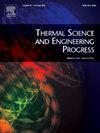Quantifying thermal deformation upon ultraviolet nanosecond laser micro-drilling of copper foil
IF 5.4
3区 工程技术
Q2 ENERGY & FUELS
引用次数: 0
Abstract
While laser micro-drilling is promising for metal foil patterning, the inevitably thermal deformation of metal foil under laser ablation significantly deteriorates the patterning accuracy. In the present work, we investigate the characteristics, mechanisms and suppressing strategy of thermal deformation in ultraviolet nanosecond laser micro-drilling of copper foil with a thickness of 100 μm by means of analytical analysis, numerical simulations and experiments. Specifically, an on-site measurement method based on laser displacement sensors is proposed and developed, which is used to dynamically monitor the deformation degree of ablated area in the on-going laser ablation process, thus providing experimental evidence of thermal deformation characteristics of copper foil. Subsequently, a thermo-mechanical coupled finite element model considering the instantaneous material removal is developed, through which the underlying mechanisms governing the thermal deformation of copper foil are elucidated, and an analytical model correlating internal stress distribution with deformation behavior is derived accordingly. Finally, a novel strategy for suppressing laser ablation-induced thermal deformation of copper foil by applying pre-tension force is proposed, the effectiveness of which is theoretically and experimentally demonstrated. And a critical value of pre-tension force for achieving the maximum reduction of 93.1 % of thermal deformation of copper foil is discovered. This work provides a feasible method to quantify and eliminate thermal deformation of copper foil under laser ablation.
紫外光纳秒激光微孔对铜箔热变形的定量研究
激光微钻孔是金属箔刻印的一种有效方法,但金属箔在激光烧蚀作用下不可避免的热变形严重影响了刻印精度。本文通过分析、数值模拟和实验等方法,研究了紫外光纳秒激光微孔加工100 μm厚度铜箔的热变形特征、机理和抑制策略。具体而言,提出并开发了一种基于激光位移传感器的现场测量方法,用于动态监测激光烧蚀过程中烧蚀区域的变形程度,从而为铜箔热变形特性提供实验依据。在此基础上,建立了考虑材料瞬时去除的热-力耦合有限元模型,阐明了铜箔热变形的基本机理,推导了铜箔内应力分布与变形行为的解析模型。最后,提出了一种利用预张力抑制激光烧蚀引起的铜箔热变形的新策略,并对该策略的有效性进行了理论和实验验证。并找到了能使铜箔热变形减少93.1%的预张力临界值。本工作为铜箔激光烧蚀热变形的量化和消除提供了一种可行的方法。
本文章由计算机程序翻译,如有差异,请以英文原文为准。
求助全文
约1分钟内获得全文
求助全文
来源期刊

Thermal Science and Engineering Progress
Chemical Engineering-Fluid Flow and Transfer Processes
CiteScore
7.20
自引率
10.40%
发文量
327
审稿时长
41 days
期刊介绍:
Thermal Science and Engineering Progress (TSEP) publishes original, high-quality research articles that span activities ranging from fundamental scientific research and discussion of the more controversial thermodynamic theories, to developments in thermal engineering that are in many instances examples of the way scientists and engineers are addressing the challenges facing a growing population – smart cities and global warming – maximising thermodynamic efficiencies and minimising all heat losses. It is intended that these will be of current relevance and interest to industry, academia and other practitioners. It is evident that many specialised journals in thermal and, to some extent, in fluid disciplines tend to focus on topics that can be classified as fundamental in nature, or are ‘applied’ and near-market. Thermal Science and Engineering Progress will bridge the gap between these two areas, allowing authors to make an easy choice, should they or a journal editor feel that their papers are ‘out of scope’ when considering other journals. The range of topics covered by Thermal Science and Engineering Progress addresses the rapid rate of development being made in thermal transfer processes as they affect traditional fields, and important growth in the topical research areas of aerospace, thermal biological and medical systems, electronics and nano-technologies, renewable energy systems, food production (including agriculture), and the need to minimise man-made thermal impacts on climate change. Review articles on appropriate topics for TSEP are encouraged, although until TSEP is fully established, these will be limited in number. Before submitting such articles, please contact one of the Editors, or a member of the Editorial Advisory Board with an outline of your proposal and your expertise in the area of your review.
 求助内容:
求助内容: 应助结果提醒方式:
应助结果提醒方式:


